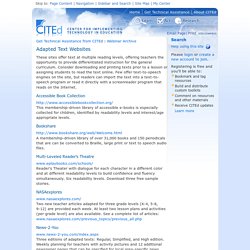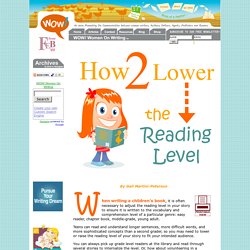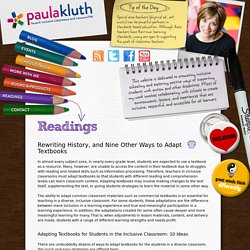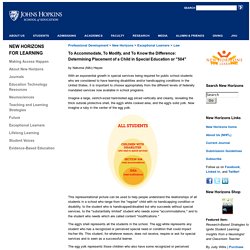

Modifying and Adapting Texts
2nd Grade Text Examples. 3rd grade text examples - العروض التقديمية من Google. Simple Text Example. Rain Forest 2nd Grade. Pandas 3rd Grade. Adapted Text Websites. These sites offer text at multiple reading levels, offering teachers the opportunity to provide differentiated instruction for the general curriculum.

Consider downloading and printing texts prior to a lesson or assigning students to read the text online. Few offer text-to-speech engines on the site, but readers can import the text into a text-to-speech program or read it directly with a screenreader program that reads on the Internet. Accessible Book Collection This membership-driven library of accessible e-books is especially collected for children, identified by readability levels and interest/age appropriate levels. Bookshare A membership-driven library of over 31,000 books and 150 periodicals that are can be converted to Braille, large print or text to speech audio files. Multi-Leveled Reader’s Theatre www.eplaybooks.com/schools/ Reader’s Theater with dialogue for each character in a different color and at different readability levels to build confidence and fluency simultaneously. How To Lower the Reading Level of Your Story.
Hen writing a children’s book, it is often necessary to adjust the reading level in your story to ensure it is written to the vocabulary and comprehension level of a particular genre: easy reader, chapter book, middle-grade, young adult.

Teens can read and understand longer sentences, more difficult words, and more sophisticated concepts than a second grader, so you may need to lower or raise the reading level of your story to fit your intended audience. You can always pick up grade level readers at the library and read through several stories to internalize the level. Or, how about volunteering in a classroom, and sitting in on reading groups? Schools can always use the extra body, and you can learn a lot about reading level standards, and even what types of stories children enjoy most. The Children's Writer's Word Book by Alijandra Mogilner lists words according to their grade level and can be another excellent resource. Understand what you read. Online summarize tool (free summarizing)
Text Compactor: Free Online Automatic Text Summarization Tool. Nonfiction Literacy and Current Events. Paul V. Sherlock Center on Disabilities. Announcify. TwistedWave. Kaizena (Voice Comments) Print Friendly and PDF. Read&Write for Google™ Readability. Dyslexie Font: The dyslexia font which eases the reading. Adapting picture books. Adapting Documents for the Classroom: Equity and Access. What Is It?

Preparing and modifying primary source documents so that all students can read and analyze them in their history classrooms. Rationale Although they are useful for engaging students in the past, and teaching them to think historically, primary source documents often use antiquated or complex language. This can pose a challenge even for able readers, let alone those who read below grade level. Adapting a variety of historical documents for use in the classroom will allow students greater access to important reading and thinking opportunities. Description Adapting documents for the classroom includes the use of excerpts, helpful head notes, and clear source information. Teacher Preparation Choose a document that is relevant to the historical question or topic that your class is studying.
Consider simplifying the document. Work on presentation. Rewriting History, and Nine Other Ways to Adapt Textbooks // Paula Kluth: Toward Inclusive Classrooms and Communities. In almost every subject area, in nearly every grade level, students are expected to use a textbook as a resource.

Many, however, are unable to access the content in their textbook due to struggles with reading and related skills such as information processing. Therefore, teachers in inclusive classrooms must adapt textbooks so that students with different reading and comprehension levels can learn classroom content. Adapting textbooks may involve making changes to the text itself, supplementing the text, or giving students strategies to learn the material in some other way. The ability to adapt common classroom materials such as commercial textbooks is an essential for teaching in a diverse, inclusive classroom. How to Modify Books & Reading Materials for Students with Autism. To Accommodate, To Modify, and To Know the Difference: Determining Placement of a Child in Special Education or "504" To Accommodate, To Modify, and To Know the Difference: Determining Placement of a Child in Special Education or "504" by Nakonia (Niki) Hayes With an exponential growth in special services being required for public school students who are considered to have learning disabilities and/or handicapping conditions in the United States, it is important to choose appropriately from the different levels of federally mandated services now available in school programs.

Imagine a large, ostrich-sized hard-boiled egg sliced vertically and cleanly, revealing the thick outside protective shell, the egg's white cooked area, and the egg's solid yolk. Now imagine a ruby in the center of the egg yolk. The egg's shell represents all the students in the school. The egg yolk represents those children who also have some recognized or perceived circumstances and/or condition that substantially limits their learning. Lastly, the ruby center of the egg yolk represents students who need modifications. Text Transformations. Prepared by Nicole Strangman and Tracey HallNational Center on Accessing the General Curriculum This article is also available in Word and PDF formats.

Note: Links have been updated on 11/6/12; Please visit the AIM Center home page. Introduction Curriculum enhancements are add-ons directed at helping students to overcome curriculum barriers that impede access to, participation, and progress within the general curriculum. Top. The Promise of Accessible Textbooks: Increased Achievement for All Students.